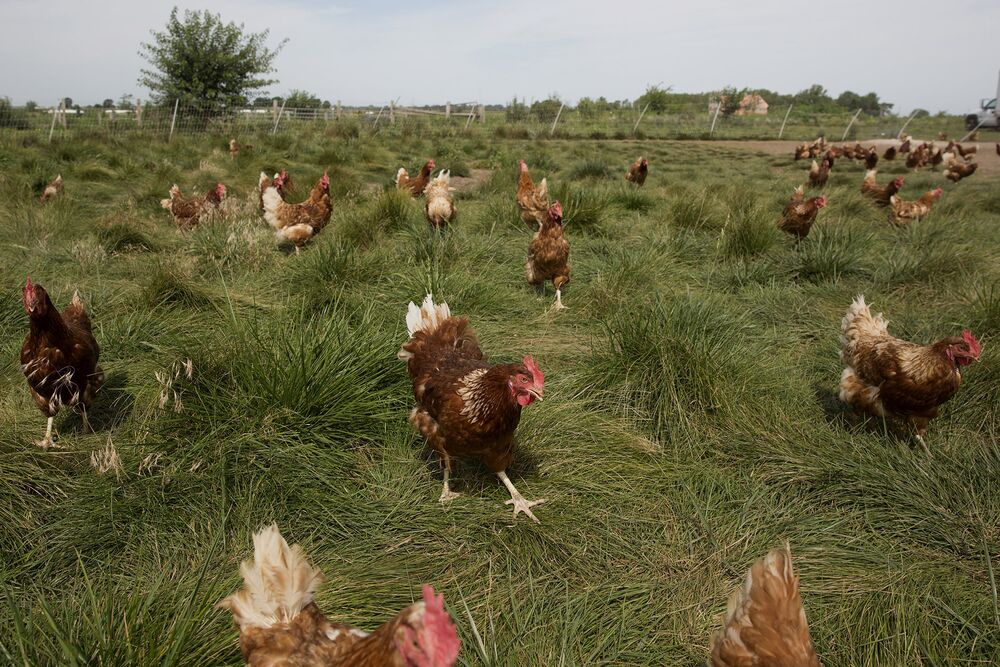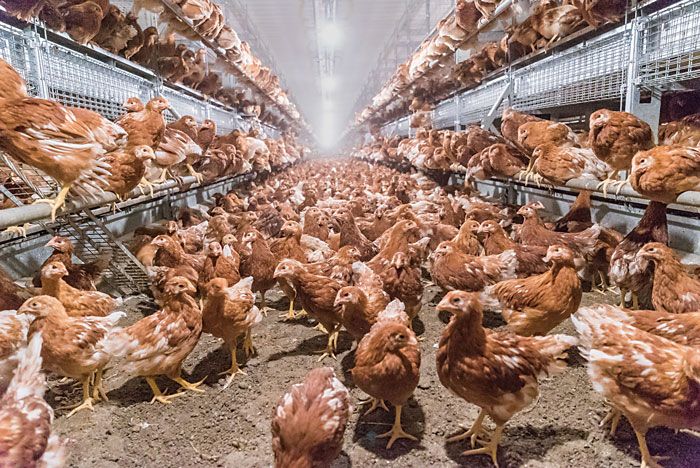What Are Cage Free Eggs
The industry listened. When it comes to purchasing eggs consumers have interests that go well beyond what they see in the carton.
 Cage Free Egg Pledge Can Companies Meet The 2025 Deadline Bloomberg
Cage Free Egg Pledge Can Companies Meet The 2025 Deadline Bloomberg
Those that do not live in cages.

What are cage free eggs. And pasture-raised birds are set to pasture with at least 108 square feet of living vegetation for at least 6 hours a day. A cage free label on a carton of eggs means they have been laid by hens that are able to roam vertically and horizontally in indoor houses according to the US. Beside above what does Cage Free Eggs Really Mean.
Cage-free hens typically live inside barns. Cage-free eggs are a step up from eggs produced by hens who live in battery cages but the hens who lay these eggs still live constrained and impoverished lives. Cage-free hens though can walk spread their wings and lay their eggs in nests activities denied to hens in battery cages.
They can freely roam a building room or enclosed. Cage-free hens usually live in large flocks of thousands of hens. This is in great contrast to most laying hens which are kept in cages so small that they cant fully open their wings much less walk or move about.
So if youre in California your regular eggs are actually cage-free at least according to the California Proposition 2 definition. Free-range chickens might have access to the outdoors. Free-range is not the same as organic.
Cage-free chickens are more prone to viruses and diseases because of the tightly enclosed space. Cage free eggs are ones that were laid by hens who live in barns or warehouses not in battery cages. Cage-free egg production while not perfect does not entail such inherent animal welfare disadvantages and is a very good step in the right direction for the egg industry Cage-free hens are spared several severe cruelties that are inherent to battery cage systems.
In theory the hens that lay eggs labeled cage-free are free to walk around the hen house to perch on roosts and to lay eggs in nests. Organic locally produced cage-free and free range are just a few of the marketing claims consumers will find on the carton as producers try to communicate the attributes. However they still likely never go outside.
This is in great contrast to most laying hens which are kept in cages so small that they cant fully open their wings much less walk or move about. For cage-free eggs the birds must be allowed to nest perch and dust-bathe but they can be kept indoors. Restaurant chains like McDonalds and retail stores like Walmart pledged to buy only eggs from cage-free hens in the coming years.
Free-range birds have access to 2 square feet of outdoor space per bird for at least 6 hours per day. Quite simply put eggs from hens labeled as cage-free are just that. Cage-free a term regulated by the USDA means that the eggs come from hens that put simply arent caged.
What I mean is there is a door and. What Are Cage Free Eggs. Respiratory problems may arise due to poor ventilation.
Cage cage-free free-range and pasture-raised are four different egg production methods. Free-range chicken eggs are eggs produced by chickens that are not raised in cages and MAY get to play outside. Eggs laid by these free range hens are also sometimes called free range eggs or free roaming eggs.
Cage-free pasture-raised organic humane. In the United States the producers of organic eggs are required to provide outdoor access to the chickens. W alking through the egg aisle of any grocery store youll be confronted with a variety of labels on cartons.
Now an estimated 38 million of the countrys 300 million egg-laying hens are cage-free almost doubled from two years ago. For many buyers where that egg came from and how it was produced are just as important as the finished product. They are available in white and brown color which comes in different sizes like small medium large and others.
Cages big enough so that hens can lie down stand up fully extend their limbs and turn around freely. The uproar from undercover videos came from images of chickens confined in small cages unable to walk or move around lined up in barns or shelters without access to the outdoors. Unfortunately it is not a USDA-regulated term so it can mean different things depending on the brand.
Cage-free eggs are produced from poultry that is allowed to roam in outdoors. Hens that produce cage eggs are kept in cages while cage-free hens have much more space but no access to. In theory the hens that lay eggs labeled cage-free are free to walk around the hen house to perch on roosts and to lay eggs in nests.
Starting in September 2015 a series of the biggest US. These eggs are relatively bigger in size and high yolk containing as compared to the caged poultry eggs. Many people who buy eggs believe free-range means the hens are not caged true and they are roaming outdoors most of the time ehuncertain.
Cage-free housing can vary from farm to farm.
 Disease Challenges Of Cage Free Egg Production Wattagnet
Disease Challenges Of Cage Free Egg Production Wattagnet
 Think You Know Free Range And Cage Free Chicken Think Again One Green Planet
Think You Know Free Range And Cage Free Chicken Think Again One Green Planet
 General Mills Reiterates Cage Free Egg Commitment
General Mills Reiterates Cage Free Egg Commitment
 Eggs That Clear The Cages But Maybe Not The Conscience The New York Times
Eggs That Clear The Cages But Maybe Not The Conscience The New York Times
:format(jpeg)/cdn.vox-cdn.com/uploads/chorus_image/image/48826279/cage-free-1.0.0.jpg) What The Fast Food Industry S Shift To Cage Free Eggs Really Means Eater
What The Fast Food Industry S Shift To Cage Free Eggs Really Means Eater
 Livestock Agency To Promote Production Of Cage Free Eggs
Livestock Agency To Promote Production Of Cage Free Eggs
 Statement To Stakeholders Uep Definition Of Cage Free Egg Production United Egg Producers
Statement To Stakeholders Uep Definition Of Cage Free Egg Production United Egg Producers
 Cage Free Egg Ads Can Exploit Food Industry S Fuzzy Definitions Fortune
Cage Free Egg Ads Can Exploit Food Industry S Fuzzy Definitions Fortune
 Are Cage Free Eggs A Scam Small Footprint Family
Are Cage Free Eggs A Scam Small Footprint Family
 Cp Foods Certifies Thailand S First Ever Cage Free Egg Standard The Poultry Site
Cp Foods Certifies Thailand S First Ever Cage Free Egg Standard The Poultry Site
 The Insanely Complicated Logistics Of Cage Free Eggs For All Wired
The Insanely Complicated Logistics Of Cage Free Eggs For All Wired
 Walmart Vows To Purchase All Eggs From Cage Free Sources By 2025 Modern Farmer
Walmart Vows To Purchase All Eggs From Cage Free Sources By 2025 Modern Farmer
 This Is The Difference Between Organic Free Range And Cage Free Eggs I M A Useless Info Junkie
This Is The Difference Between Organic Free Range And Cage Free Eggs I M A Useless Info Junkie
:max_bytes(150000):strip_icc()/what-are-cage-free-eggs-2216573-FINAL-5bd8c35c46e0fb0026ea20ae.png)
Comments
Post a Comment